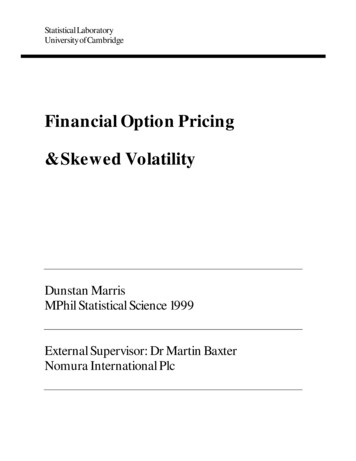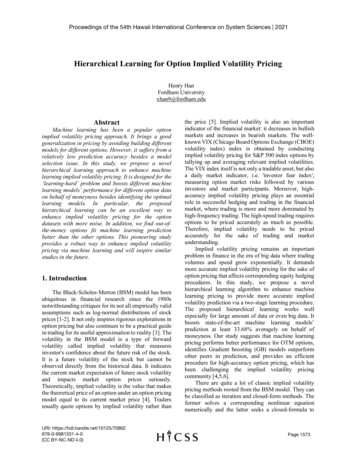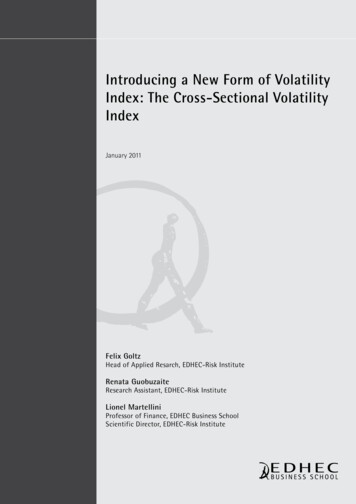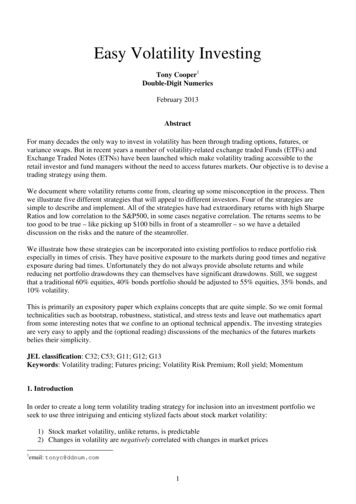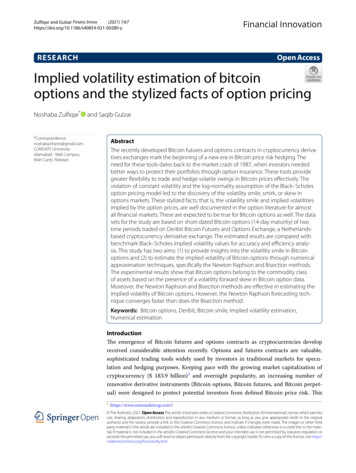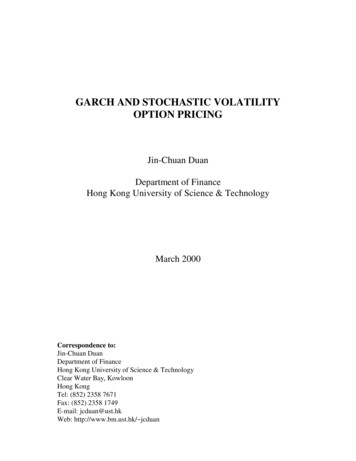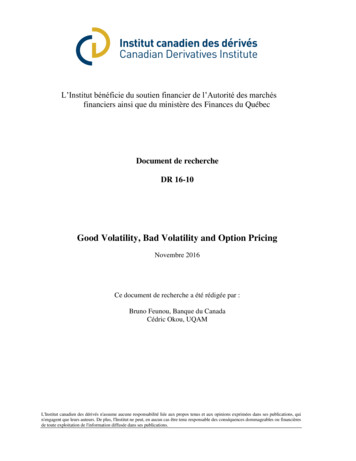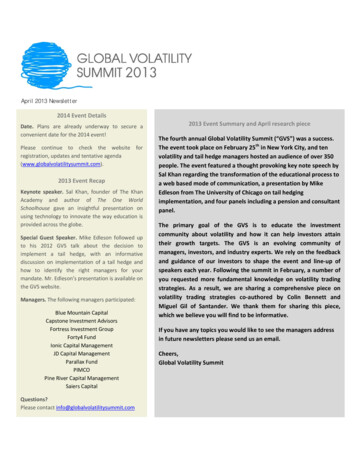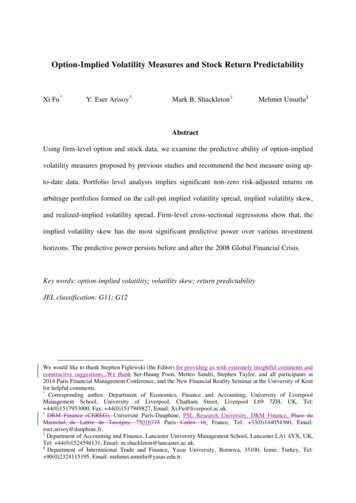
Transcription
Option-Implied Volatility Measures and Stock Return PredictabilityXi Fu *Y. Eser Arisoy†Mark B. Shackleton ‡Mehmet Umutlu §AbstractUsing firm-level option and stock data, we examine the predictive ability of option-impliedvolatility measures proposed by previous studies and recommend the best measure using upto-date data. Portfolio level analysis implies significant non-zero risk-adjusted returns onarbitrage portfolios formed on the call-put implied volatility spread, implied volatility skew,and realized-implied volatility spread. Firm-level cross-sectional regressions show that, theimplied volatility skew has the most significant predictive power over various investmenthorizons. The predictive power persists before and after the 2008 Global Financial Crisis.Key words: option-implied volatility; volatility skew; return predictabilityJEL classification: G11; G12We would like to thank Stephen Figlewski (the Editor) for providing us with extremely insightful comments andconstructive suggestions.,We thank Ser-Huang Poon, Metteo Sandri, Stephen Taylor, and all participants at2014 Paris Financial Management Conference, and the New Financial Reality Seminar at the University of Kentfor helpful comments.*Corresponding author. Department of Economics, Finance and Accounting, University of LiverpoolManagement School, University of Liverpool, Chatham Street, Liverpool L69 7ZH, UK, Tel: 44(0)1517953000, Fax: 44(0)1517949827, Email: Xi.Fu@liverpool.ac.uk.†DRM Finance (CEREG), Université Paris-Dauphine, PSL Research University, DRM Finance, Place duMaréchal de Lattre de Tassigny, 75016775 Paris Cedex 16, France, Tel: 33(0)144054360, Email:eser.arisoy@dauphine.fr.‡Department of Accounting and Finance, Lancaster University Management School, Lancaster LA1 4YX, UK,Tel: 44(0)1524594131, Email: m.shackleton@lancaster.ac.uk.§Department of International Trade and Finance, Yasar University, Bornova, 35100, Izmir, Turkey, Tel: 90(0)2324115195, Email: mehmet.umutlu@yasar.edu.tr.
1 IntroductionOptions are forward-looking instruments and option-implied measures contain valuableinformation regarding investors’ expectations about the return process of the underlying asset.Option-implied volatility has received particular attention due to the time-varying property ofvolatility which is a widely used parameter in asset pricing. It is well-documented thatimplied volatility extracted from option prices provides good forecasts of future volatility. 1 Ina similar vein, recent studies examine the predictive ability of different option-impliedvolatility measures in the cross-section of stock returns. However, despite growing literature,there is no clear understanding of i) whether different option-implied volatility measurescapture distinct information about the volatility curve, ii) which measures are important forinvestors in predicting stock returns, and iii) which measures would outperform in predictingstock returns in dynamically managed portfolios. By comparing the predictive ability ofalternative option-implied volatility measures proposed in the literature, in the context ofreturn predictability, this study highlights whether the proposed option-implied volatilitymeasures are fundamentally different to each other and whether their predictive ability differsby investment horizon. 2The relationship between option-implied volatility and stock return predictability is ofrecent interest. 3 For example, An, Ang, Bali and Cakici (2014) focus on the implied volatilityof individual options and document the significant predictive power of implied volatility in1See Christensen and Prabhala (1998), Szakmary, Ors, Kim and Davidson (2003), Poon and Granger (2005),Kang, Kim and Yoon (2010), Taylor, Yadav and Zhang (2010), Yu, Lui and Wang (2010), and Muzzioli (2011)for studies on the predictive ability of option-implied volatility on future volatility.2The option-implied volatility measures used in this study are: the call-put implied volatility spread ( CPIV ),the implied volatility skew ( IVSKEW ), the “above-minus-below” ( AMB ), the “out-minus-at” of calls ( COMA ),the “out-minus-at” of puts ( POMA ), and the realized-implied volatility spread ( RVIV ). Details about thesemeasures can be found in Section 2.2.3For example, Arisoy (2014) use returns on crash-neutral ATM straddles of the S&P 500 index as a proxy ofthe volatility risk, and returns on OTM puts of the S&P 500 index as a proxy of the jump risk, and find that thesensitivity of stock returns to innovations in aggregate volatility and market jump risk can explain thedifferences between returns on small and value stocks and returns on big and growth stocks. Doran, Petersonand Tarrant (2007) find supportive evidence that there is predictive information content within the volatilityskew for short-term horizon.1
predicting individual stock returns. More specifically, large increases in call (put) impliedvolatilities are followed by increases (decreases) in one-month ahead stock returns. Bali andHovakimian (2009) investigate whether realized and implied volatilities can explain thecross-section of monthly stock returns and document that there is a positive relationshipbetween the call-put implied volatility spread and one-month ahead stock returns. Cremersand Weinbaum (2010) focus on the predictive power of the call-put implied volatility spreadand provide evidence that this measure predicts weekly returns to a greater extent for firmsfacing a more asymmetric informational environment.Meanwhile, motivated by the empirically documented volatility skew for equity options,several studies examine the predictive power of information captured by options withdifferent moneyness levels. 4 For example, Xing, Zhang and Zhao (2010) examine the impliedvolatility skew, which is the difference between out-of-the-money put and at-the-money callimplied volatilities, and find a significantly negative coefficient on the implied volatilityskew in Fama-MacBeth cross-sectional regressions. Baltussen, Grient, Groot, Hennink andZhou (2012) include four different implied volatility measures in their study: out-of-moneyvolatility skew (i.e., implied volatility skew in Xing, Zhang and Zhao, 2010), realized versusimplied volatility spread, at-the-money volatility skew (i.e., the difference between the at-themoney put and call implied volatilities), and weekly changes of at-the-money volatility skew.By analyzing weekly stock returns, they find negative relationships between weekly returnsand four option-implied measures. In addition to two common factors used in previousstudies (at-the-money call-put implied volatility spread and out-of-money implied volatilityskew), Doran and Krieger (2010) construct three other measures based on implied volatilityextracted from call and put options. These three measures are “above-minus-below”, “out4The phenomenon that the implied volatility of equity options with low strike prices (such as deep out-of-themoney puts or deep in-the-money calls) is higher than that of equity options with high strike prices (such asdeep in-the-money puts or deep out-of-the-money calls) is known as volatility skew (Hull, 2012). The volatilityskew is widely observed for equity options (Bollen and Whaley, 2004; Bates, 2003; Gârleanu, Pedersen, andPoteshman, 2007; and Xing, Zhang and Zhao, 2010).2
minus-at” of calls, and “out-minus-at” of puts. 5 Results in their study show that differencesbetween at-the-money call and put implied volatilities and those between out-of-the-moneyand at-the-money put implied volatilities both capture information about future equityreturns.From these studies, it is not clear whether separately constructed option-impliedvolatility measures in the literature capture fundamentally different information in predictingstock returns. In the presence of other volatility measures, some of these volatility measuresmay be redundant in predicting stock returns. Building on aforementioned studies, this papercompares the ability of the various option-implied volatility measures to predict one-week tothree-month ahead returns. Addressing the question of which option-implied volatilitymeasure(s) outperforms alternatives in predicting stock returns and whether their predictiveability persists over different investment horizons is crucial, having implications for portfoliomanagers and market participants. These groups can adjust their trading strategies and formportfolios based on option-implied volatility measure(s) that has the strongest predictivepower and thus earn excess returns.To compare the predictive power of option-implied volatility measures, we first formquintile portfolios sorted with respect to six option-implied volatility measures: the call-putimplied volatility spread ( CPIV ), the implied volatility skew ( IVSKEW ), the “above-minusbelow” ( AMB ), the “out-minus-at” of calls ( COMA ), the “out-minus-at” of puts ( POMA ),and the realized-implied volatility spread ( RVIV ). Then, we construct zero-cost arbitrageportfolios by taking a long position in portfolios with the highest implied volatility measureand a short position in portfolios with the lowest implied volatility measure. The arbitrageportfolio will have significantly non-zero return if there is a statistically significant5The “above-minus-below” is the difference between the mean implied volatility of in-the-money puts and outof-the-money calls and the mean implied volatility of in-the-money calls and out-of-the-money puts. “Outminus-at” of calls (puts) is the difference between the mean implied volatility of out-of-the-money calls (puts)and the mean implied volatility of at-the-money calls (puts).3
relationship between stock returns and the corresponding option-implied volatility measure.However, portfolio level analysis might suffer from the aggregation effect due to omission ofuseful information in the cross-section because it does not control for the effects of otheroption-implied volatility measures and firm-specific effects simultaneously. Consequently,we further perform firm-level cross-sectional regressions to assess the predictive power of allsix interlinked option-implied volatility measures.Our study contributes to the literature in several aspects. First, this study compares thepredictive ability of six different implied volatility measures. To the best of our knowledge,this is the most comprehensive study that compares the predictive power of option-impliedvolatility measures. Secondly, our study tests the predictive power of different option-impliedvolatility measures on stock returns over various investment horizons. This helps investorsbetter understand the informational content captured by different option-implied volatilitymeasures. Finally, the sample period, from 1996 until 2014, is longer than those used inprevious studies. This enables us to analyze whether the predictive power of option-impliedvolatility measures documented previously is still significant in extended periods using recentdata in the US markets.The paper is organized as follows. Section 2 discusses the data and the methodology.Section 3 examines the relationship between expected stock returns and different optionimplied volatility measures through portfolio level analysis and firm-level cross-sectionalregressions. Section 4 discusses potential reasons for the predictive power of option-impliedvolatility measures through discussions on informed trading, skewness preference, constraintson short-sale, and delta hedging. Section 5 offers concluding remarks.4
2 Data and Methodology2.1 Data SourcesOur data come from several different sources. Financial statement data are downloadedfrom Compustat, monthly and daily stock return data are from CRSP, and option impliedvolatility data are from OptionMetrics. The factors in Fama-French (1993) three-factor model(i.e., MKT , SMB , and HML ) are obtained from Kenneth French’s online data library. 6To distinguish at-the-money options, we follow the criteria in Bali and Hovakimian(2009). 7 That is, if the absolute value of the natural logarithm of the ratio of the stock price tothe exercise price is smaller than 0.1, an option is denoted at-the-money. We denote optionswith the natural logarithm of the ratio of the stock price to the exercise price smaller than -0.1as out-of-the-money call (in-the-money put) options. Options with the natural logarithm ofthe ratio of the stock price to the exercise price larger than 0.1 are denoted in-the-money call(out-of-the-money put) options. Then, we calculate the average implied volatilities fordifferent kinds of options across all eligible options at the end of each calendar month. Oursample period starts from January 1996 and ends in December 2014 (i.e., 19 years). 82.2 Option-Implied Volatility MeasuresFor equity options, it is normal to observe the existence of volatility skew (i.e., thevolatility decreases as the strike price increases). As discussed in the previous section,empirical studies document that a different part of the volatility curve can capture relevant6Available at: ench/data library.html.Only stock data for ordinary common shares (CRSP share codes 10 and 11) are retained. Furthermore, closedend funds, REITs (SIC codes 6720-6730 and 6798) and those companies whose shares were trading less than 5are excluded. For option data, we focus on the last trading day of each calendar month. We only retain stockoptions with days-to-maturity greater than 30 but less than 91 days. After deleting options with zero openinterest or zero best bid prices and those with missing implied volatility, we further exclude options whose bidask spread exceeds 50% of the average of the bid and ask prices and options which are traded for less than 0.25.8The first observation of the implied volatility is available at the end of January, 1996. So the return observationstarts from February, 1996. The last observation of monthly stock returns is the return in December, 2014. Sincethis study uses three-month holding period return, the last observation for three-month return should be thereturn during the period from October, 2014 to December, 2014, whereas the last observation for each volatilitymeasure is constructed at the end of September 2014. So the sample consists of 225 monthly observations. Thesample size is discussed in detail in section 3.1.75
information about future stock returns (Bali and Hovakimian, 2009; Baltussen et al., 2012;Cremers and Weinbaum, 2010; Xing, Zhang and Zhao, 2010; Doran and Krieger, 2010; etc.).In following subsections, we discuss how different option-implied volatility measures reflectinvestors’ expectations about future market conditions.2.2.1 Call-Put Implied Volatility SpreadDrawing upon the method documented in Bali and Hovakimian (2009), CPIV isconstructed as follows: CPIV IVATM ,call IVATM , put(1)where CPIV is the call-put implied volatility spread, IVATM ,call is the average of impliedvolatilities extracted from all at-the-money call options, and IVATM , put is the average ofimplied volatilities extracted from all at-the-money put options available on the last tradingday in each calendar month.If investors expect decreases in underlying asset prices in the near future, they willchoose to buy put options and sell call options. In this case, prices of put options will increasewhile prices of call options will decrease, suggesting higher implied volatilities for putoptions and lower implied volatilities for call options. A more negative CPIV predictsdecreases in underlying asset prices (i.e., more negative returns) and vice versa. Thus, it isexpected that future asset returns should be positively correlated with CPIV .2.2.2 Implied Volatility SkewTo construct IVSKEW proposed by Xing, Zhang and Zhao (2010), we calculate thedifference between the average of implied volatilities extracted from out-of-the-money putoptions and the average of implied volatilities extracted from at-the-money call options:IVSKEW IVOTM , put IVATM ,call6(2)
where IVSKEW is the implied volatility skew, IVOTM , put is the average of implied volatilitiesextracted from out-of-the-money put options at the end of each calendar month.If investors expect that there will be a downward movement in underlying asset price,they will choose to buy out-of-the-money put options. An increase in the demand for out-ofthe-money put options further leads to increases in their prices, and thus in their impliedvolatilities. In this case, the spread between out-of-the-money put implied volatilities and atthe-money call implied volatilities will become larger. IVSKEW reflects investor’s concernabout future downward movements in underlying asset prices. A higher IVSKEW indicates ahigher probability of large negative jumps in underlying asset prices. So, IVSKEW isexpected to be negatively related to future returns on underlying assets.2.2.3 Above-Minus-BelowAMB represents the difference between average implied volatility of options whosestrike prices are above current underlying price and average implied volatility of optionswhose strike prices are below current underlying price. Following Doran and Krieger (2010),this study defines AMB as:AMB ( IVITM , put IVOTM ,call ) ( IVITM ,call IVOTM , put )2(3)where IVITM , put , IVOTM ,call , IVITM ,call , and IVOTM , put are mean implied volatilities of all in-themoney put options, all out-of-the-money call options, all in-the-money call options, and allout-of-the-money put options, respectively.The variable AMB captures the difference between the average implied volatilities oflow-strike-price options and the average implied volatilities of high-strike-price options.Thus, AMB captures the volatility curve asymmetry by investigating both of its tails. More(less) negative values of AMB are indications of more trading of pessimistic (optimistic)investors and thus lower (higher) future stock returns are expected.7
2.2.4 Out-Minus-AtDoran and Krieger (2010) also introduce two other measures, which capture thedifference between out-of-the-money and at-the-money implied volatilities of call/put options. COMA IVOTM ,call IVATM ,call(4) POMA IVOTM , put IVATM , put(5)All measures in these two equations have the same meanings as in the previous equations (1)– (3).In contrast to AMB , COMA ( POMA ) use only out-of-the-money and at-the-money call(put) options to capture the volatility curve asymmetry. In the option market, it is observedthat out-of-the-money and at-the-money call and put options are the most liquid and heavilytraded whereas in-the-money options are not traded much (Bates, 2000). It is also reportedthat bullish traders generally buy out-of-the-money calls while bearish traders buy out-of-themoney puts (Gemmill, 1996). To follow a trading strategy based on volatility curveasymmetry, it is more convenient to construct a measure using the most liquid options forwhich data availability is not a concern. Positive COMA is associated with bullishexpectations, indicating an increase in the trading of optimistic investors. However, a positivePOMA reflects the overpricing of out-of-the-money puts relative to at-the-money puts due toincreased demand for out-of-the-money puts that provide hedging against negative jump risk.2.2.5 Realized-Implied Volatility SpreadIn the spirit of Bali and Hovakimian (2009), we calculate realized volatility ( RV ),which is the annualized standard deviation of daily returns over the previous month, and thenconstruct a realized-implied volatility spread, RVIV , as follows:RVIV RV IVATMwhere IVATM is the average implied volatility of at-the-money call and put options.8(6)
The variable RVIV is related to volatility risk, which has been widely tested inempirical papers. When testing the volatility risk premium, previous articles focus on thedifference between realized volatility and implied volatility (proxied by a variance swaprate). However, rather than using a variance swap rate (which is calculated by using optionswith different moneyness levels), we focus on at-the-money implied volatility (a standarddeviation measure).2.2.6 Discussion on Option-Implied Volatility MeasuresTo better show that various option-implied volatility measures capture differentinformation about the volatility curve, Exhibit 1 plots call and put implied volatilities ofAdobe System Inc. on December 29, 2000. Options included in this Exhibit have anexpiration date of February 17, 2001 (i.e., two months ahead).[Insert Exhibit 1 here]From this exhibit, it is clear that CPIV captures the middle of the volatility curve,which reflects small deviations from put-call parity. IVSKEW reflects the left of the putvolatility curve and the middle of the call volatility curve. The AMB measure captures thetails of the volatility curve. COMA captures the right side and middle of the volatility curvefor call options, while POMA captures the left side and middle of the volatility curve for putoptions.From call and put options with the same strike price and time-to-expiration, it is easy toobserve small deviations from put-call parity. That is, small differences between paired calland put implied volatilities are apparent. However, these deviations do not necessarilyindicate arbitrage opportunities (discussed in Section 4.5). Furthermore, measures IVSKEW ,AMB , COMA and POMA provide some indications about the shape of the implied volatilitycurve. Lower AMB and COMA indicate more negatively skewed implied volatility curves.9
Lower POMA and IVSKEW indicate less negatively skewed implied volatility curves. 9Thus, we expect to observe a positive relationship between AMB or COMA and stockreturns, but a negative relationship between IVSKEW or POMA and stock returns.Overall, CPIV , IVSKEW , AMB , COMA and POMA capture different parts of thevolatility curve. Therefore it is interesting to test whether these measures (i.e., different partsof the volatility curve) have different predictive ability for asset returns. Taken together, allfive option-implied volatility measures capture much of the information contained in thecross-section of implied volatilities (Doran and Krieger, 2010). However, some of them are POMA CPIV . So, these three measures cannot be includedinterdependent, e.g., IVSKEWin the same model because of the multi-collinearity problem. In addition to these measures,we further include another volatility measure used in Bali and Hovakimian (2009), RVIV .2.3 Firm Specific VariablesIn order to see whether option-implied volatility measures can predict stock returns aftercontrolling for known firm-specific effects, we also include several firm-level controlvariables. To control for the size effect documented by Banz (1981), we use the naturallogarithm of a company’s market capitalization (in thousands of USD) on the last trading dayof each month. Following Fama and French (1992), we use the book-to-market ratio asanother firm-level control variable. Jegadeesh and Titman (1993) document the existence of amomentum effect (i.e., past winners, on average, outperform past losers in short futureperiods). We use past one-month returns to capture the momentum effect. Stock tradingvolumes are included as another variable (measured in hundred millions of shares traded inthe previous month). The market beta reflects the historical systematic risk and is calculatedby using daily returns available in the previous month using the standard CAPM9Compared to POMA , IVSKEW uses at-the-money call options, which are more liquid than at-the-money putoptions and are seen as the investors’ consensus on the firm’s uncertainty (Xing, Zhang, and Zhao, 2010).10
framework. 10 The bid-ask spread is used to control for liquidity risk. It is defined as the meandaily percentage bid-ask spread over the previous month where the percentage bid-ask spreadis the difference between ask and bid prices scaled by the mean of the bid and ask prices (Baliand Hovakimian, 2009). Finally, we also control for option trading volume (measured inmillions of options traded in the previous month), which is documented to containinformation about future stock prices. 113 Results3.1 Descriptive ResultsExhibit 2 presents some descriptive statistics, such as mean, standard deviation,minimum, 5th percentile, 25th percentile, median, 75th percentile, 95th percentile andmaximum of each volatility measure, sample size available for each measure, as well aspairwise correlations. 12[Insert Exhibit 2 here]On the basis of all available observations on the last trading day of each month duringthe sample period, Panel A of Exhibit 2 reports descriptive statistics for option-impliedvolatility measures. Therefore, the sample size varies for each measure. It is observed thatCPIV , AMB , COMA and RVIV have negative means, while those for IVSKEW andPOMA are positive. The last column of Panel A shows that, the sample size for CPIV islargest (i.e., 230,884), whereas the sample size for AMB is smallest (i.e., 66,104). CPIV isconstructed by using near-the-money call and put options while AMB is constructed byusing deep out-of-the-money and in-the-money call and put options. It is expected that more10It is required that stocks should have more than 15 daily observations in the previous month for betacalculation.11Pan and Poteshman (2006) find strong evidence that option trading volume contains information about futurestock prices. Doran, Perterson, and Tarrant (2007) incorporate option trading volume when analyzing whetherthe shape of implied volatility skew can predict the probability of a market crash or spike.12The option-implied volatility measures in Exhibit 2 are reported in decimals, not in percentages. The fullsample presented in Panel A consists of 4,999 US firms, and the intersection sample in Panel B consists of 3,317US firms.11
near-the-money options are available than deep out-of-the-money and in-the-money options.So the larger sample size for CPIV and the much smaller sample size for AMB arereasonable.Panel B of Exhibit 2 reports the descriptive statistics of the intersection sample whichconsists of stocks with all option-implied volatility measures available. The intersectionsample has 62,562 stock-month observations. 13 CPIV , AMB , COMA and RVIV havenegative means, whereas IVSKEW and POMA have positive means. The negative samplemean of CPIV shows that put options on individual companies tend to have higher averageimplied volatility than calls. Individual firms tend to have negative implied volatility skew asseen by the positive sample means of POMA and IVSKEW and negative sample means ofAMB and COMA . These results support the view that, on average, implied volatility curve isasymmetric for individual equities as observed in Exhibit 1.As discussed in Section 2.2, IVSKEW is the difference between POMA and CPIV . Onaverage, 15.98 percent of the value of the negative skew stems from the difference betweenat-the-money implied volatility of puts and at-the-money implied volatility of calls, and theother 84.02 percent can be due to the difference between out-of-the-money implied volatilityand at-the-money implied volatility of puts. Given the positive relationship between stockreturns and CPIV and the negative relationship between stocks returns and IVSKEWdocumented in previous studies (Bali and Hovakimian, 2009; Cremers and Weinbaum, 2010;Doran and Krieger, 2010; and Xing, Zhang, and Zhao, 2010), we infer whether or not POMA(which represents the left-hand side of the put implied volatility curve) plays a significantrole in predicting stock returns. If there is no empirical evidence in favor of significantpredictive ability for POMA , the predictive power of IVSKEW should be driven by the13The intersection sample in Doran and Krieger (2010) consists of 62,076 company months during the periodfrom January 1996 to September 2008. Thus, the size of our intersection sample during the same period issmaller than that of Doran and Krieger (2010). This can be due to the different moneyness criteria and morecontrol variables used in this study.12
difference between at-the-money put implied volatilities and the at-the-money call impliedvolatilities.Panel C of Exhibit 2 presents pairwise correlations; there are four high averagecorrelations. The correlation between CPIV and IVSKEW is -0.6580, the correlationbetween IVSKEW and POMA is 0.7333, the correlation between AMB and COMA is0.6678, and the correlation between AMB and POMA is -0.6842. Other pairwisecorrelations are relatively low. These high correlations indicate that there might be someinformation overlap in option-implied measures. By trying to avoid overlap, this study takesinto account potential multicollinearity problem when conducting multivariate firm-levelcross-sectional regressions.3.2 Portfolio Level AnalysisIn order to examine the relationship between quintile portfolio returns and each volatilitymeasure, we construct quintile portfolios, and further form a “5-1” arbitrage portfolio withinthe full sample by holding a long position on the quintile portfolio with the highest volatilitymeasure and a short position on the quintile portfolio with the lowest volatility measure. Then,we test the null hypothesis that the “5-1” arbitrage portfolio has a mean return equal to zero.If the average return on the “5-1” arbitrage portfolio is significantly positive (negative), thereis a positive (negative) relationship between the volatility measure and portfolio returns.Results for portfolio level analysis are presented in Exhibit 3.[Insert Exhibit 3 here]We first examine the effect of CPIV on subsequent one-month portfolio returns. Forboth equally-weighted and value-weighted portfolios, returns increase monotonically fromportfolios with the lowest CPIV to portfolios with the highest CPIV . The mean return onthe equally-weighted “5-1” arbitrage portfolio is 1.12% per
volatility which is a widely used parameter in asset pricing. It is well-documented that implied volatility extracted from option prices provides good forecasts of future volatility. 1 In a similar vein, recent ine the predictive ability of studies exam implied different option-volatility measures in the cross-section of stock returns.
